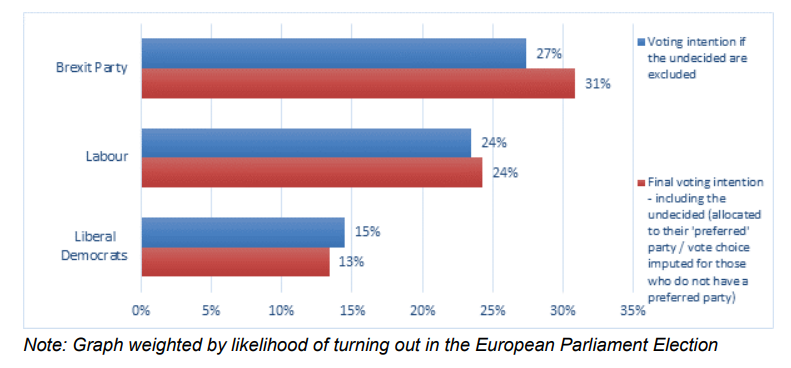Kantar voting intention polls for the European Parliament Elections (14th – 21st May 2019) show:
- Brexit Party (27.4%)
- Labour (23.5%)
- Liberal Democrats (14.5%)
- Conservatives (12.9%)
- Greens (7.7%)
- Change UK (5.4%)
- Others inc. SNP/PC and UKIP (8.7%)
Turnout and voting intentions
One key consideration in forecasting an election outcome is to accurately estimate turnout. In this election it is particularly challenging. Turnout for European Parliament Elections (EPE) is traditionally low (it was c.32% of the Voting Age Population in 2014) but we have reason to believe that it could be different this time, given the way the Brexit debate continues to dominate UK politics.
In estimating the turnout for this election, we have used a model we developed based on the 2015 and 2017 General Elections. This implies that turnout will be 53% among the Voting Age Population, which would be much higher than for any previous EPE.
Our model suggests that The Brexit Party supporters are the most likely to vote. Thus, if turnout is instead at ‘normal’ EPE levels, we would expect the Brexit Party to lead by a more substantial margin (at least 7%pts over Labour).
Secondly, a number of likely voters are still undecided (or unwilling to say who they will vote for). Additional questions have been included to tease out their preferences. While the Brexit Party does very well among those that have already made up their mind, they appear to be less favoured among those who will vote but are yet to make their final choice.
Our final voting intention figures incorporate an educated guess about who these people will vote for. If they were excluded – an approach used by some other pollsters - the Brexit Party would have a greater vote share, and the Remain-supporting national parties would have smaller shares. Instead of 27%, the Brexit Party would be on 31%.
Nevertheless, under any scenario, our forecast is for a clear Brexit Party lead over both Labour and the Conservatives.
Graph of Brexit Party/Labour/LibDem vote shares under different inclusion rules

Methodological information
The survey data and further details on the methodological approach can be found here.
A total of 2,316 interviews were conducted online among adults living in Great Britain between 14th and 21st May 2019. Interviews were conducted using the Kantar Research Express Online Omnibus, which uses the Kantar online access panel as its sample source.
The data was weighted to match population totals for age, gender, working status, 2017 General Election voting patterns, 2016 EU referendum voting patterns, education, region, and likelihood to vote in the next General Election. Any use of this research must cite Kantar as the source.

